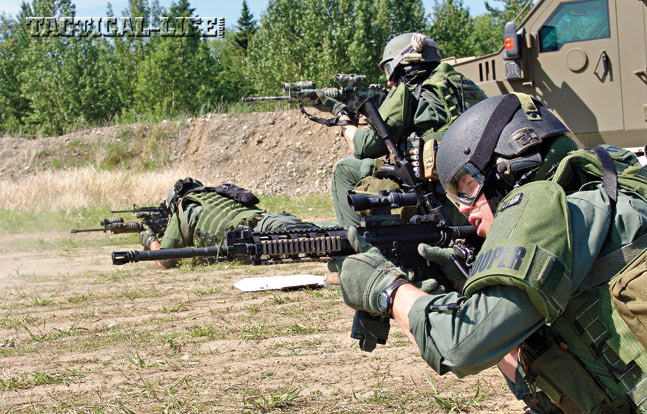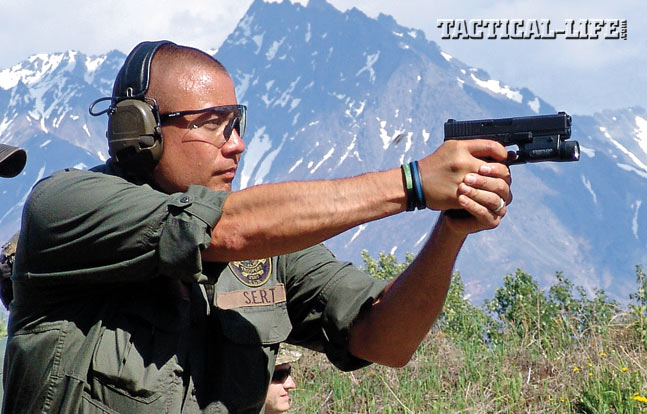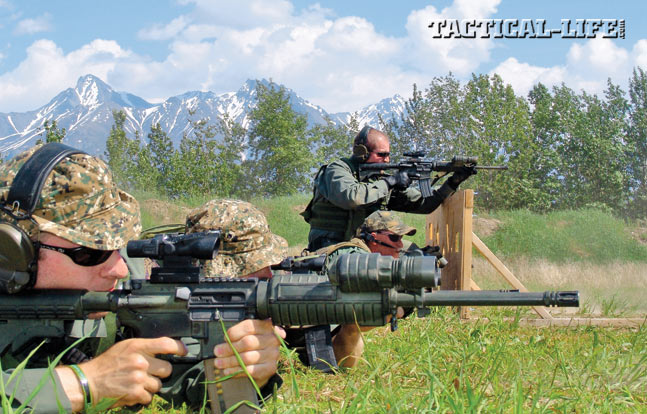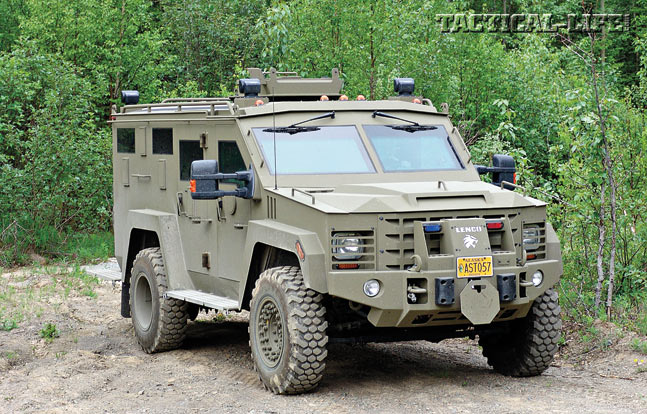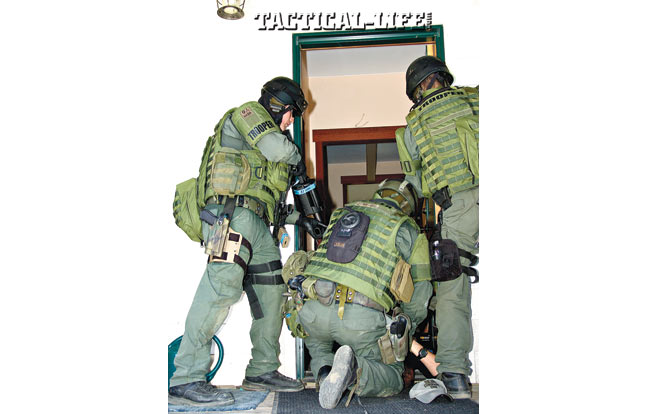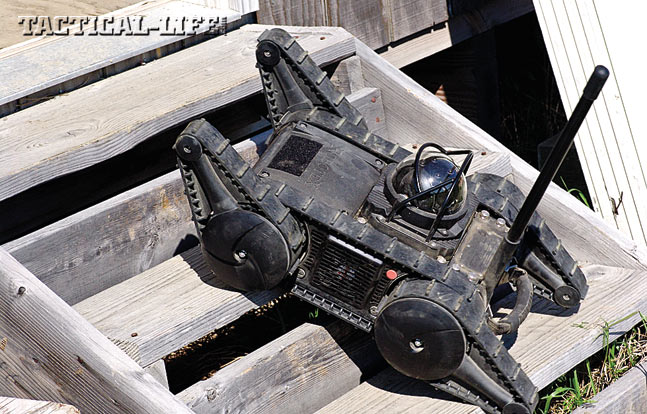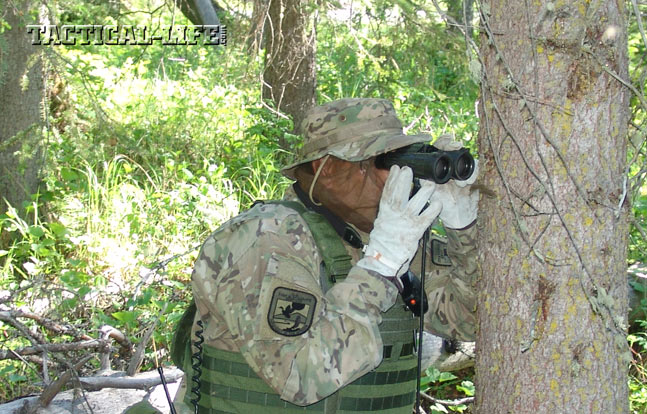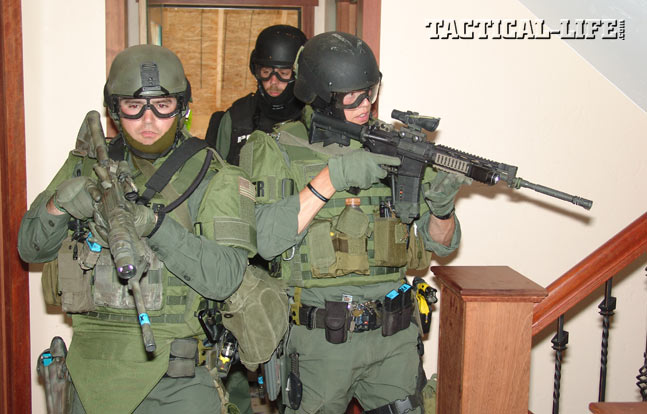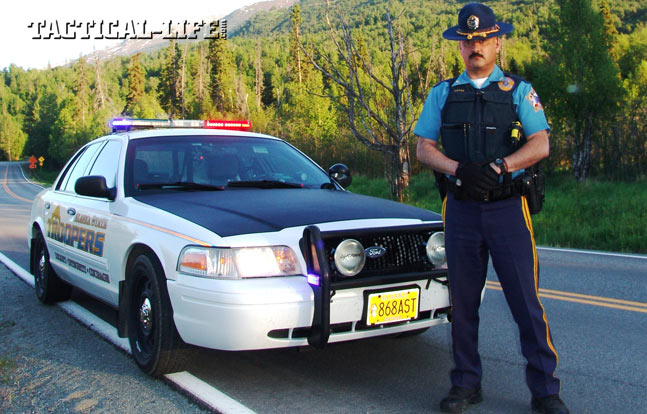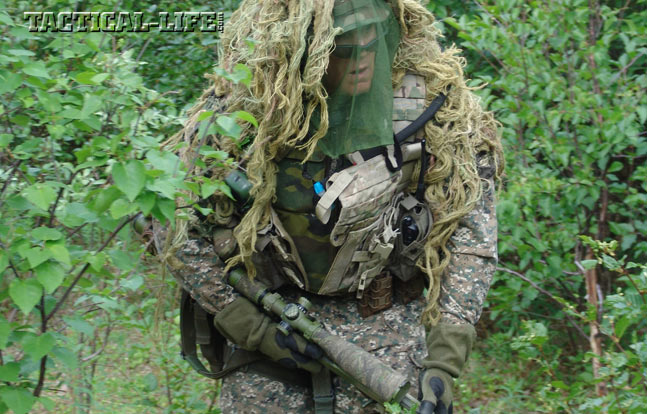Deep in the old growth of the Matanuska-Susitna Valley in south-central Alaska, the Alaska State Trooper (AST) sniper, wearing a full ghillie suit and armed with a Remington 700P LTR rifle, paused next to a tree scarred by the antlers of rutting moose. I accompanied the AST sniper, who was looking to find an overwatch position in response to a reported hostage situation in a house located deep in the Alaskan wilderness. Sometimes sinking up to his knees in the layers of brush, ferns and leaves from the ancient trees towering a hundred feet above the forest floor, the trooper alternated between moving and stopping to listen.
“The command post then went to work coordinating the snipers, perimeter security and entry teams as well as the negotiators, who began to contact the people inside to resolve the situation…”
Everything around him pulled, pricked or bit at him, as thorny stalks clung to his legs and mosquitoes and flies swarmed by the thousands. Nearby, another trooper encountered a moose and her calf—he then gave them a wide berth, as he knew a protective adult cow was a very dangerous threat. After a long approach, the sniper finally saw the peak of the house and began the stalk, finding a ravine that fed down to the opening where the house was located. He crawled slowly until a large stump blocked his way but also provided excellent cover. At that point he set up and began making observations and taking pictures that he, as well as several other snipers located around the structure, quickly transmitted back to the command post that put together an accurate understanding of the situation, terrain and structure. With the intel flowing in from troopers now all around the target, the command post close to the outer perimeter was able to map the number and locations of the people inside the house as well as the physical layout of the doors, windows and stories.
The command post then went to work coordinating the snipers, perimeter security and entry teams as well as the negotiators, who began to contact the people inside to resolve the situation. Using everything from corded “throw phones,” loudspeakers and robot-delivered cell phones, the negotiators began the tough and sensitive dialogue—all designed to control a potentially dangerous situation and have a peaceful outcome for everyone involved.
Advertisement — Continue Reading Below
While the equally well-hidden perimeter teams ensured no other personnel entered or left the cordoned area, the designated entry team waited for deployment inside their Lenco BearCat armored vehicle, which could come in a minute, hours or even days. The command post gathered the information that continued to come in to understand the disposition of the hostages and hostage-takers as well as the mindset of the bad guys to determine the next steps to be taken. Is there time for extended negotiations? Are the hostages in imminent danger? Are the hostage-takers unstable or suicidal? What is the best gas plan? Who else can be contacted to help reach the hostage-takers? All these questions and a thousand more are processed and answered to achieve the desired endpoint: the safe release of the hostages and the peaceful resolution of this crisis.
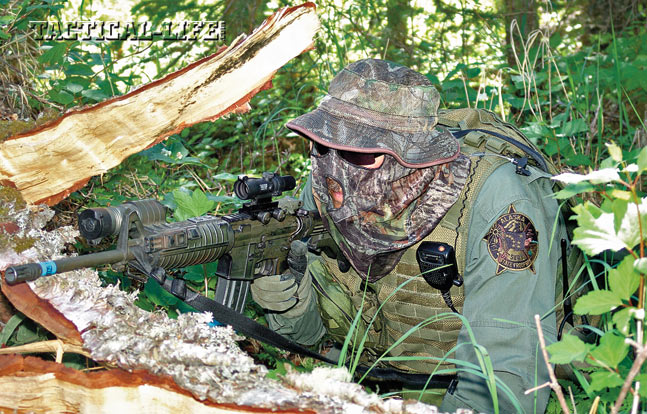
SERT On Duty
This was the beginning of just one of the many tactical and law enforcement exercises undertaken during the yearly, two-week, integrated “SERT Summer School” training course for the Special Emergency Response Team (SERT). The Alaska SERT is composed of the Alaska State Troopers as well as other local and state agencies that fill the 52 allocated positions on the three teams based out of Anchorage, Fairbanks and Soldotna. The SERT uses the Summer School as a basic SWAT course, which includes competitive skills training and evaluation as well as several day-long scenarios that fully exercise every aspect of tactical performance, crisis management and command and control. The scenarios, staged in diverse and challenging locations, allow the SERT to deploy and exercise all of their assets, including negotiators and operators. Each scenario has the team deploy, gather information and respond to an ever-changing situation that in some cases include a dynamic entry against active role-players using Simunition training ammunition.
Advertisement — Continue Reading Below
“Although it has a widely dispersed population and mostly rural communities, Alaska still has many of the criminal problems of major cities and urban areas…”
The Alaska State Troopers are Alaska’s elite statewide police force with approximately 650 sworn troopers and hundreds of civilian support personnel. Before they were made an official organization at the start of WWII, various federal agencies and local police handled law enforcement in Alaska, with some villages still relying on “public safety officers” who had police training but did not carry firearms. Unlike other states, Alaska is not divided into counties with their own police departments and sheriffs. The AST performs those duties, which include serving civil papers and mental health custody orders, and serve as the only police force available throughout Alaska to enforce the criminal and traffic laws, hunting and fishing regulations and more, while employing a wide variety of land, snow, air and water patrol vehicles.
Although it has a widely dispersed population and mostly rural communities, Alaska still has many of the criminal problems of major cities and urban areas, including “designer” drug manufacturing and sales, assault, domestic violence and even bootlegging, as many areas are considered “dry,” making it illegal to transport alcoholic beverages. Most of what the AST handles, just like in the lower 48, involves minor criminal or civil disputes between individuals that need to be resolved before more serious crimes are committed. I rode along with several Alaska State Troopers and was impressed with how they were able to not only enforce laws but also were able to calm people and help resolve their issues. Several situations were defused and successfully resolved because the AST were able to tell the Alaskans in conflict, a lot of them just relationships in crisis, the legal options available to them.
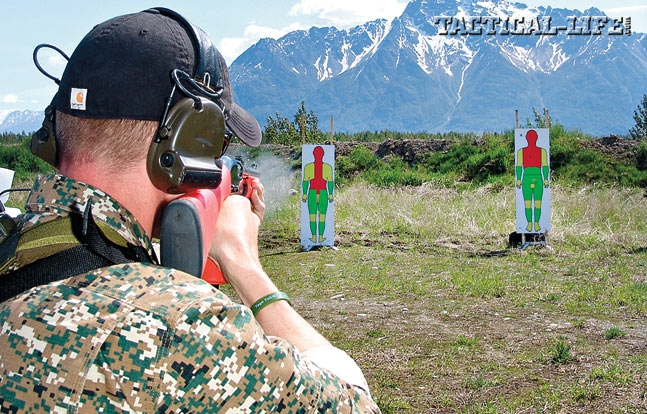
Trooper Hardware
Advertisement — Continue Reading Below
When the Alaska State Troopers operate in remote areas, they usually cannot expect rapid backup, so what they bring to a situation is usually all that they have to win a fight. That means their equipment and weapons have to be reliable and capable of operating in conditions of snow, rain and saltwater as well as temperatures that can vary over 120 degrees between summer and winter. This is why their weapons have to be the best, and with their use of the well-proven Colt M4 5.56mm carbine, the Remington 870 12-gauge shotgun, the Remington 700P LTR .308 precision rifle and the Glock 22 Gen4 .40 pistol, they have achieved that.
The AST also has the practiced capability to evaluate and monitor dangerous situations using their Robotex Avatar II tactical robot. It is a small, tracked, self-powered robot that can be sent into a building for reconnaissance, communicate at a safe distance with two-way audio and one-way video, day or night, and it can deliver small items, even up stairs. The AST SERT frequently practices with the Avatar II, including during the SERT Summer School, where it was used extensively during the training scenarios, especially the hostage situation.
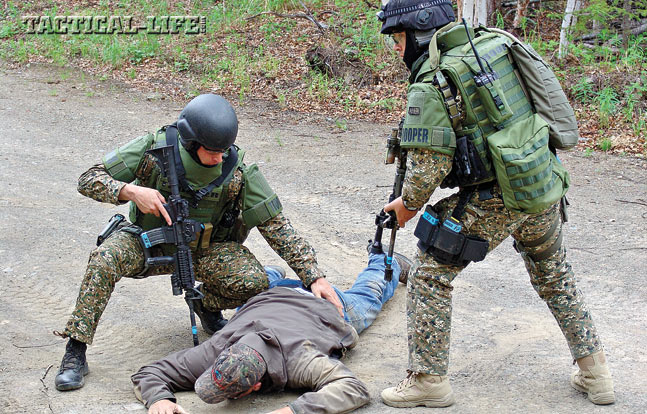
Hostage Standoff
Advertisement — Continue Reading Below
After lengthy negotiations with the bad guy role-players, who were experienced negotiators themselves, the situation seemed to become very real as the minutes dragged into hours. But the troopers remained vigilant at their assigned posts. The unexpected still was in play as the training was based on actual, recent standoff situations. Sudden threats from both inside and outside the perimeter challenged the team’s attention and capabilities, and there were brief exchanges of Simunition gunfire. Robot messengers were used to deliver communication devices and food after successful discussions with the bad guy role-players, and while doing, so the command post gained useful intel about the situation inside the house. Finally, after successful negotiations, the role-players began to talk of surrender, which resulted in the BearCat moving the team to approach and then apprehend the role-players, ending the day’s very successful training.
The AST uses both their strength and intelligence to help them provide peace and security for Alaska’s widespread residents. The troopers are tough and dedicated. They rely on their knowledge and tools on-hand to resolve situations from traffic stops in towns, to ship boardings on the sea, to domestic squabbles in remote villages. Based on working with them, it is evident that the Alaska State Troopers are as truly unique in purpose, dedication and effort as the magnificent part of the United States that they are sworn to protect.
